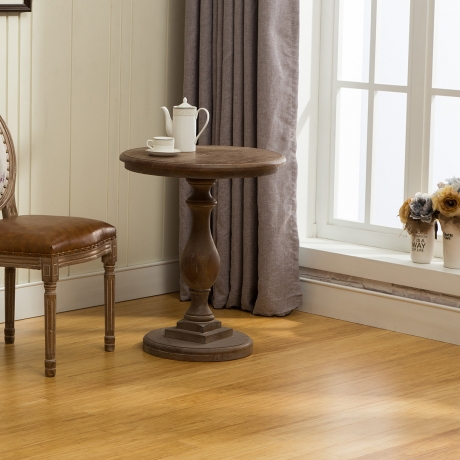Bamboo flooring has gained popularity as a sustainable, stylish, and affordable alternative to traditional hardwoods. But homeowners and industry professionals alike often ask: Does bamboo flooring scratch easily? The answer depends on several key factors — from how the bamboo is harvested, to how it's manufactured, and finally, how it's finished and maintained. As a flooring factory technologist, I've seen firsthand how each stage of production impacts the durability and scratch resistance of wide plank bamboo flooring.
Let's take a detailed look at how bamboo becomes flooring, how wear and tear affects its surface, and what makes some bamboo floors more scratch-resistant than others.
The Journey Begins: Harvesting the Right Bamboo
It all starts in the bamboo groves of China and Southeast Asia, where Moso bamboo is the species of choice for flooring. Moso bamboo reaches maturity in about 5–6 years, significantly faster than hardwood trees. However, harvesting too early compromises fiber density, which in turn affects the hardness and durability of the final product.
High-quality manufacturers only harvest mature culms—thicker, denser bamboo stalks that have reached full lignification. These stalks are more structurally sound and offer superior resistance to impacts and scratches. Poor harvesting practices, on the other hand, result in lighter, spongier material that's more prone to denting and surface scratches.
Processing and Manufacturing: How It Affects Scratch Resistance
Once harvested, bamboo must be processed into flooring planks. This involves several steps:
- Stripping and Boiling: Bamboo stalks are split into strips, then boiled to remove starches that attract pests.
- Drying and Carbonizing: Depending on the desired color, the bamboo may be heat-treated (carbonized) or left natural. Carbonizing darkens the material but also reduces its hardness.
- Compression or Strand Woven Manufacturing: This is where the biggest difference in scratch resistance comes in.
Strand woven bamboo is made by shredding the bamboo fibers and compressing them under intense heat and pressure with adhesives. This process creates a very dense, durable flooring—often harder than oak or maple. In contrast, horizontal or vertical grain bamboo (where strips are glued side-by-side) is less dense and more susceptible to scratching.
So, if scratch resistance is a priority, strand woven bamboo is often the best choice.
The Glue That Binds: Adhesives Matter Too
The type and quality of adhesive used during manufacturing also play a major role in the flooring's integrity. Low-quality glues can break down over time or fail under pressure, leading to plank separation or surface instability, both of which can make the floor more vulnerable to scratches.
Reputable manufacturers use phenol-formaldehyde or EPI adhesives that are not only strong but also low in VOCs (volatile organic compounds). These adhesives ensure a solid, durable bond between bamboo strands or layers, contributing to a more scratch-resistant floor.
Lacquer and Finish: The First Line of Defense
Scratch resistance isn't just about what's under the surface — it heavily depends on the topcoat as well. Most bamboo flooring is finished with multiple layers of UV-cured polyurethane lacquer, often with an added layer of aluminum oxide, which enhances surface hardness.
A high-quality lacquer system typically includes:
- 3–7 layers of UV-cured coating
- Abrasion-resistant additives (like aluminum oxide)
- Anti-scratch and anti-scuff technology
Floors finished with cheap or insufficient lacquer may look fine on installation day but will quickly show wear in high-traffic areas. A robust finish acts as a shield, taking the initial brunt of scratches from pet claws, furniture legs, or dirt under shoes.
Real-World Wear and Tear: What to Expect
Even the hardest floor isn't immune to damage. Strand woven bamboo with a premium finish holds up well under normal household conditions, but no floor is completely scratch-proof.
Here's a realistic view of how bamboo flooring behaves in different environments:
- High-traffic homes with pets: Expect minor surface scratches over time, especially near doorways or play areas. Regular sweeping and protective pads help.
- Commercial spaces: Bamboo can perform well in low-traffic offices or boutiques, but in high-impact zones, additional coatings or mats may be needed.
- Shoes and debris: Grit under shoes is the enemy of all flooring. Bamboo is no exception. Keeping entrances clean can significantly reduce wear.
Quality Control: The Unsung Hero
Behind every durable bamboo floor is a rigorous quality control process. At the factory level, we test for:
- Surface hardness (Janka test)
- Coating adhesion
- Scratch resistance (Taber abrasion test)
- Dimensional stability
Only planks that meet strict mechanical and aesthetic standards make it into final packaging. However, not all factories follow the same protocols. It's critical to choose bamboo flooring from manufacturers that adhere to ISO-compliant quality management systems, as well as environmental certifications like FSC and Floorscore.
Final Thoughts: Durability Depends on the Details
The durability and scratch resistance of bamboo flooring are not one-size-fits-all. It depends on:
- The age and quality of the harvested bamboo
- The manufacturing method (strand woven being the strongest)
- The adhesives and lacquers used
- The quality control behind the product
Choose carefully, and bamboo can offer a beautiful, tough, and environmentally responsible flooring option that holds up well under real-world use. But like any flooring, it requires care, smart installation, and the right expectations to perform at its best.






